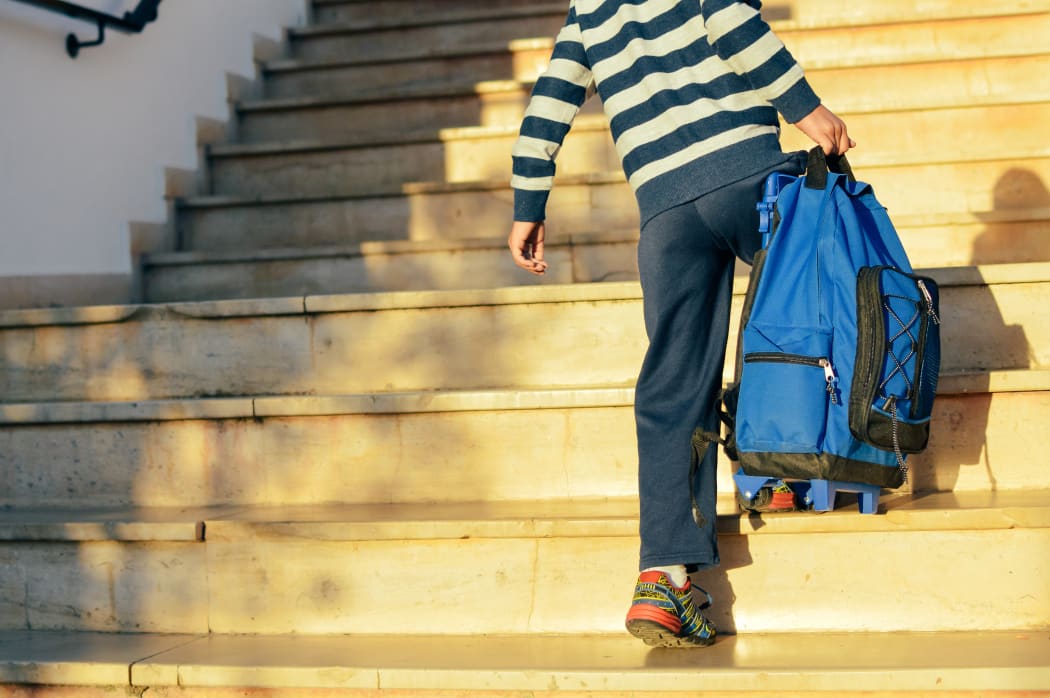Heavy and overcrowded schoolbags are causing serious danger to children's growing spines, with 10 pounds (4.5kg) in a backpack equalling 72 pounds (33kg) of force to a student's spine, research by a world-leading spinal surgeon shows.
Australian studies have also found that heavily loaded backpacks can contribute to posture problems and related neck and back pain in children that can lead to permanent spinal damage in later life.
While previous studies have described the forces exerted on the spines of young people from backpacks, this one aimed to use finite element analysis to assess the effects of incremental weights in a backpack on the spine, Dr Ken Hansraj tells Jim Mora.

Photo: 123RF
“As far as I’m aware, Jim, this is the first study to truly assess or to check the forces seen from the point of the spine.
“The study says when you have 1 pound (0.45kg) in the backpack it really carries seven pounds (3.2kg) of force to the spine when you’re in neutral alignment – which is the most efficient position for the spine - and when you lean forward 20 degrees, it becomes 12 times.”
Leaning forward is natural tendency, but Dr Hansraj says it can make the situation worse, with the force on the spine changing from 7(x) to 12(x) – (x) being a unit of measure for the load of force.
Some countries now recommend that youth not carry more than 10-15 percent of their body weight in a backpack, he says.
“My study does not really make a recommendation per se. My goal in doing this study is to really carry forth a scientific discussion [to] where people can start to say, how much is enough? How much will strengthen the body and how much will destroy the body?”
One tip he gives to young students is not to sling their backpack over only one shoulder.
“When you carry the backpack with one shoulder, it is exactly half the force dispersed, so it’s actually 2(x). So you carry the same amount of force on one shoulder. It would be better for you to carry that backpack on both shoulders and split the weight and force on shoulders in two.”
The effects vary from person to person, he says.
University students, for instance, may be less adversely affected with carrying a heavy load than younger students.
“Your spine – not very actively, but certainly actively – is still growing [during high school] and you certainly don’t want to stress the spine that’s growing and overload it. But again I didn’t prove that in my study, that’s my opinion.
“Someone that carries a weight to school for 20 minutes is not as risky as the Australian or New Zealander soldier who’s carrying backpacks with 100 pounds (45kg) five hours a day.”
One pathway to a future of less carrying, he suggests, is embracing digital textbooks.
“The digital information, once made, is just easily transferable from student to student.
“It’s almost 2020 and [we’re saying] ‘we have some new information, let’s do things differently, let’s not load up the bodies of our young ones or anyone’, we can be smart about it.
Hansraj hopes the study will encourage people to take more notice of what they're carrying and how they carry their backpacks.
“I remind people to think about your packing. Be very careful what you put in there, certainly don’t hoard things in your backpack, I tell people to embrace digital textbooks.
“My message is neutral alignment – which is proper posture – ears above the shoulder, and angel wings back, which is your chest open. I recommend wearing both straps, I say keep the backpack closest to the body.”

